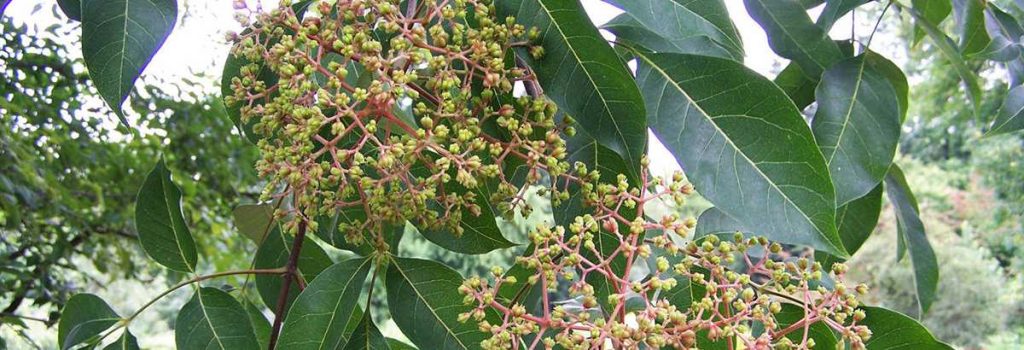Evodia – Honey Tree

The tree which PRANDINI’S GARDEN NURSERY CENTRE would like to introduce is not for the usual esthetic and production reasons but because of its ecological value. Evodia Tetradium Danielli, commonly called The Honey Tree, PRANDINI’S GARDEN NURSERY CENTRE is convinced it will attract the attention of the most impassioned greenfingers.
It belongs to the Rutaceae, and originally from Eastern regions of China and Korea it presents itself as a characteristically similar to our common beech but with a difference in that its trunk has a very smooth bark which is green/ grey, practically the same as the beech, not only does it have a speedy growth but even from a young age the wood is hard and dense.
If isolated it has a spherical shape growth with a similar diameter to dimension ratio. While if in competition with other trees it tends to reach upwards and once surpass it opens its foliage crown. Its leaves are deciduous, circa 15 cms long and quite narrow. The leaves are a beautiful shy green. The veining is clear, almost white / cream and very visible, whilst the secondary veining is less evident, but what renders the plant a plea the leaves specific is in the complex, they give the plant a pleasant aspect. Approaching the cold period and before the leaves start to fall they change colour and take on the classic yellow colour. The Honey Tree once adult, resists the cold very well but in its first years it could become irreparably damaged if not shielded and protected. A curiosity, universally it is known as the honey tree, but in the USA.
It is the American Tilia.
TERRAIN
The Honey Tree adapts to all soils, even in poor soil, whether it is acid or basic. Obviously in fertile soil the tree will develop faster and better. It suffers only from stagnant irrigation.
FLORA AND FRUIT
The flowers of the honey tree are somewhat small and emit an intense perfume. The shape reminds us of a little water lily, they are grouped together to form what appears to be one flower. This tree is both unisex and hermaphrodite. The most important thing about the Honey Tree is the flowering.
It buds in late summer and blooming lasts for at least a month. The flowers are abundant and millefere. Towards October gives way to small fruit which is orange and shaped like little pumpkins and reach maturity towards November the open to allow 476 seeds to fall, they are black/brown, shiny flat and oily.
USE AND HEALTH GIVING PROPERTIES
Here we analyze the properties of the plant. The flowering period of the honey tree, the duration and the high content of pollen render the tree ideal for bee cultivation and for the whole eco system in general the late blooming of the plant is not rare but an anomaly. Its high content of pollen in the flowers are indispensable elements conducive to the bee and indeed the whole beehive. The quantity of pollen contained in a single flower means a bee will visit 40/ 60 times. Necessary visits to the Honey Tree are reduced to £ or 4 times. From an average Robinia (acacia) tree, bees will produce 6 – 8 kgs of honey: from the Honey Tree this becomes 1.100kg/ 1.300.
In periods of rest time and the absence of flowers, the beekeeper himself has to provide the food as the bees in the hive and the honey which proceeds from the pollen of the flowers of the Honey Tree is not very appetizing to man, but excellent for the bees. Properties of this honey are notable and exceed simple nutrition. The Honey Tree attacks of nosemiasi, a typical Winter diarrhea which can kill the plant. It is also quite resistasnt to mites and other pests. Commercially the can be sold as a sanitary treatment which is complete, biological and free , useful to the hive as well as an important source of food. In fact many flying animals take advantage of its antbacterial and anti viral properties. As already mention the Honey tree not only grows very fast but is resistant which allows us to use its wood for two reasons. Firstly its young branches can be used to tools 8handles etc) secondly as a biomass source of energy that given its consistency gives good yield. In wild uncultivated areas it can be used as a stabilizer in areas at risk to landslides.
POTTING PRUNING AND CULTIVATION
Potting is very simple. In the first few years after planting, it is advisable to cut the branches which are a height of two metres, and that ìs all that is necessary to do. It ìs possible following the winter, to contain the plant at any age. If it is destined to be planted as a perennial. The Honey Tree needs a tutor for the first years until it obtains an aesthetically pleasing aspect.
I Italy there are no noted parasite attacks or fungus attacks to the Honey Tree.
